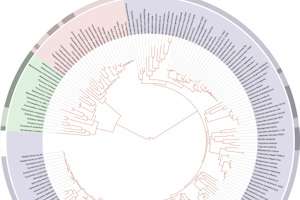Genomes uncover life's early history

A University of Manchester scientist is part of a team which has carried out one of the biggest ever analyses of genomes on life of all forms.
This has allowed them to map the evolutionary history of eukaryotic genes in unprecedented detail - giving insight into the mechanisms of evolution in the very earliest forms of life.
Their paper, which is published in Nature, builds upon the work of famous palaeontologist Stephen Jay Gould who suggested that even though evolution is usually a slow process, it can sometimes take great jumps forward in a relatively short space of time. This theory was called 'punctuated equilibrium'.
The team, including the Faculty of Life Sciences' Professor James McInerney, wanted to look at the different ways in which eukaryotic and prokaryotic life evolved to see if there were any clues to how evolution could do these great leaps forward. Traditional models had shown that lateral gene transfer (LGT) (the flow and swapping of genes between two individuals) happened in prokaryotes and thus helped explain the enormous diversity they have compared to eukaryotes. The team therefore asked: could LGT in eukaryotes explain these great leaps forward?
The project lead, Professor Bill Martin of the University of Dusseldorf explained the results:
"The big surprise of the study was that eukaryotes, don't engage in this kind of continuous gene swapping nearly as much [as prokaryotes] – though when they do, it's a really, really important event and in early evolution, it corresponded to the origin of organelles. These events were huge evolutionary leaps."
Organelles are parts of the cell that scientists can use to help differentiate between eukaryotic and prokaryotic cells. Eukaryotes crucially have structures like mitochondria and chloroplasts, mini-factories that work in the cell to provide energy for the organism. Research has shown that both mitochondria and chloroplasts evolved from two cells coming together to share genes and form a 'hybrid' organism.
Importantly the team's computer model has shown that after this initial hybrid-forming stage, the organism starts to lose some of its newly acquired genetic information. Professor McInerney explains: "It's like in a game of chess. The cells starts out with two full sets of genes, one from each symbiotic partner, all lined up at either end of the board.
"But during evolution, the pieces are removed from the board one by one, so that at the end of the game almost no pieces are left, and from those that are left one tries to reconstruct how the game went, retracing the moves back in time."
The team's research has therefore shown that these evolutionary great leaps forward can take place when prokaryotes and eukaryotes mix their genes together in an endosymbiotic event. This evidence gives strong support to the theory of punctuated evolution and can explain the origins of complex life here on Earth.
More information: "Endosymbiotic origin and differential loss of eukaryotic genes." Nature (2015) DOI: 10.1038/nature14963
Journal information: Nature
Provided by University of Manchester





















